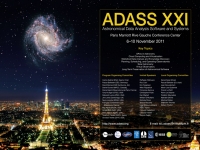Aitor Ibarra (XMM-Newton SOC. ESA-ESAC), Carlos Gabriel (XMM-Newton SOC, ESA-ESAC)
Abstract
Nowadays hardware and system infrastructure evolve on time scales much shorter than the typical duration of space astronomy missions. Data processing software capabilities have to evolve to preserve the scientific return during the entire experiment life time. Software preservation is a key issue that has to be tackled to keep the data usable over many years.
The X-ray Space Observatory XMM-Newton, now in operation for more than 11 years, produces large amounts of data, reduced interactively by observers using the distributed XMM-Newton Scientific Analysis System (SAS), as the primary analysis package.
XMM-Newton data will not be superseded by new or better observations for many years and their full scientific exploitation could require repeatedly more refined analysis compared to that stored in the archive during the next decade.
We present RISA (Remote Interface to Science Analysis) as a solution to decouple data processing software and infrastructure life-cycles, using JAVA applications and web-services wrappers to existing software. This architecture employs embedded SAS in virtual machines which assures a homogeneous job execution environment.
We will also present the first studies to bring to life the data processing software of the EXOSAT mission, the first X-ray ESA mission launched in 1983, using the generic RISA approach. Poster in PDF format
Paper ID: P061
Poster Instructions
|

